Clinical Judgement and Decision-making in Nursing: A Case Study - Post Fall Patient Assessment
VerifiedAdded on 2023/04/11
|6
|1085
|485
AI Summary
This article discusses the assessment and management of post-fall patients in nursing, including risk factors, assessment techniques, and evidence-based interventions. It also provides a case study and recommendations for preventing future falls.
Contribute Materials
Your contribution can guide someone’s learning journey. Share your
documents today.
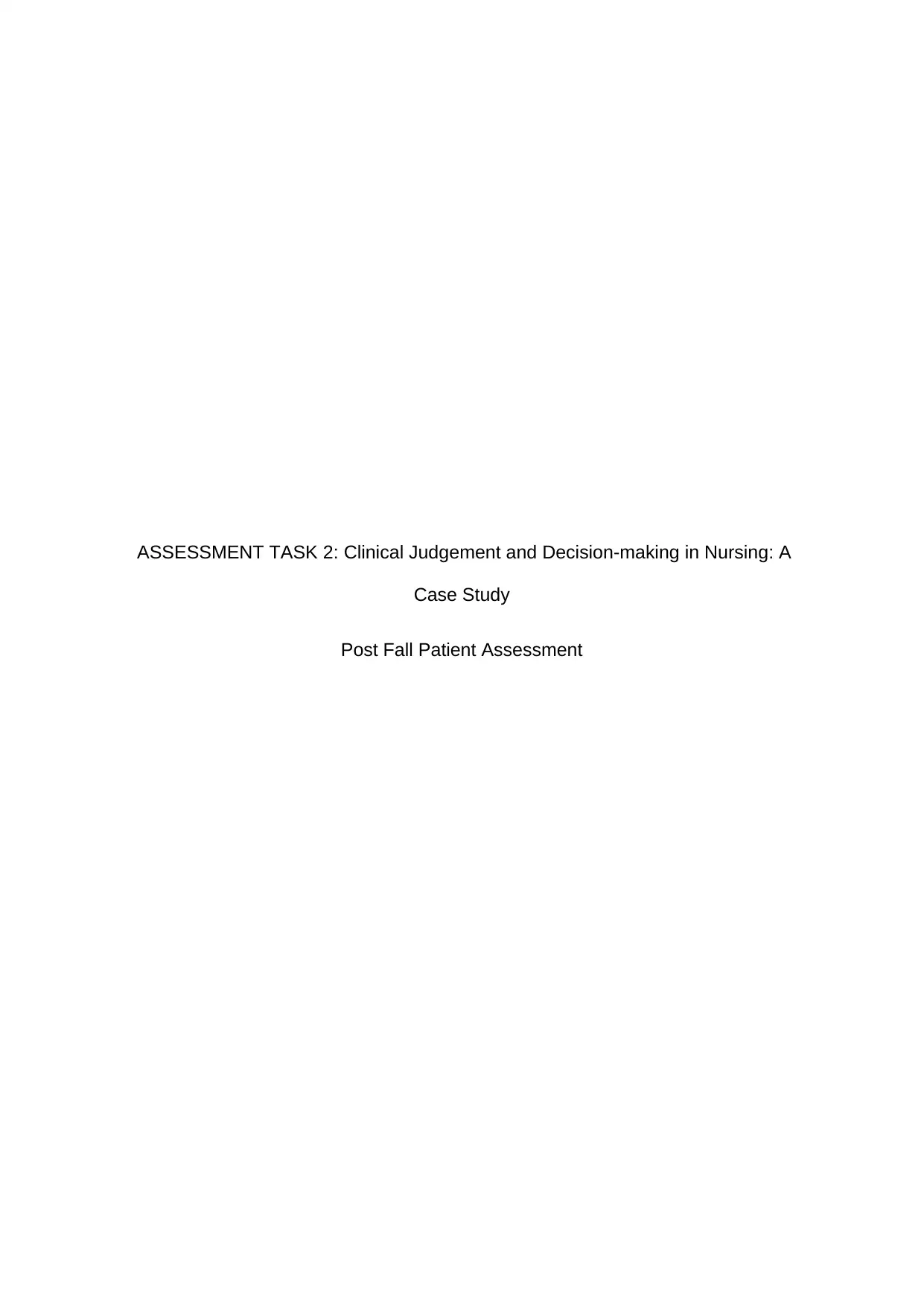
ASSESSMENT TASK 2: Clinical Judgement and Decision-making in Nursing: A
Case Study
Post Fall Patient Assessment
Case Study
Post Fall Patient Assessment
Secure Best Marks with AI Grader
Need help grading? Try our AI Grader for instant feedback on your assignments.
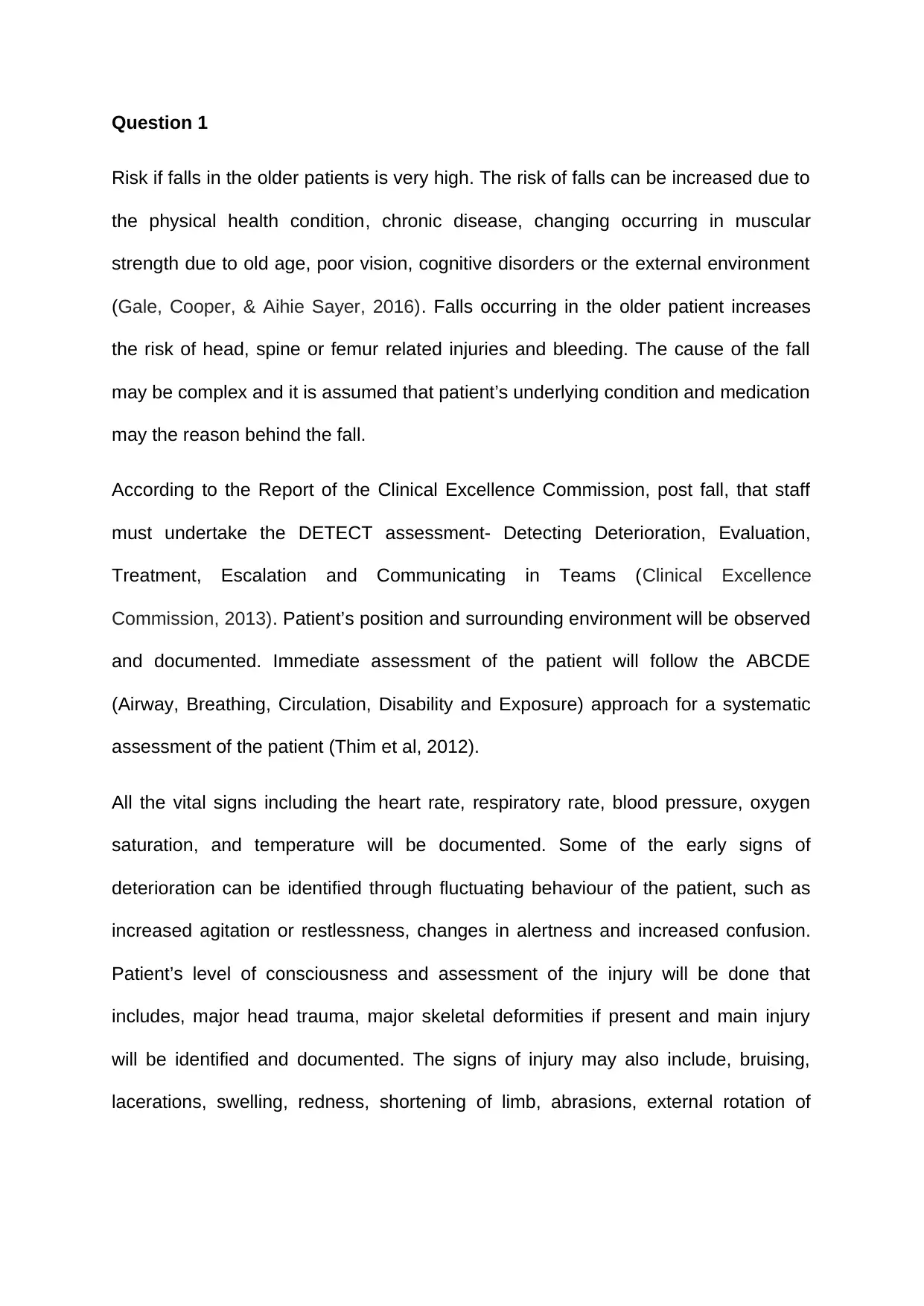
Question 1
Risk if falls in the older patients is very high. The risk of falls can be increased due to
the physical health condition, chronic disease, changing occurring in muscular
strength due to old age, poor vision, cognitive disorders or the external environment
(Gale, Cooper, & Aihie Sayer, 2016). Falls occurring in the older patient increases
the risk of head, spine or femur related injuries and bleeding. The cause of the fall
may be complex and it is assumed that patient’s underlying condition and medication
may the reason behind the fall.
According to the Report of the Clinical Excellence Commission, post fall, that staff
must undertake the DETECT assessment- Detecting Deterioration, Evaluation,
Treatment, Escalation and Communicating in Teams (Clinical Excellence
Commission, 2013). Patient’s position and surrounding environment will be observed
and documented. Immediate assessment of the patient will follow the ABCDE
(Airway, Breathing, Circulation, Disability and Exposure) approach for a systematic
assessment of the patient (Thim et al, 2012).
All the vital signs including the heart rate, respiratory rate, blood pressure, oxygen
saturation, and temperature will be documented. Some of the early signs of
deterioration can be identified through fluctuating behaviour of the patient, such as
increased agitation or restlessness, changes in alertness and increased confusion.
Patient’s level of consciousness and assessment of the injury will be done that
includes, major head trauma, major skeletal deformities if present and main injury
will be identified and documented. The signs of injury may also include, bruising,
lacerations, swelling, redness, shortening of limb, abrasions, external rotation of
Risk if falls in the older patients is very high. The risk of falls can be increased due to
the physical health condition, chronic disease, changing occurring in muscular
strength due to old age, poor vision, cognitive disorders or the external environment
(Gale, Cooper, & Aihie Sayer, 2016). Falls occurring in the older patient increases
the risk of head, spine or femur related injuries and bleeding. The cause of the fall
may be complex and it is assumed that patient’s underlying condition and medication
may the reason behind the fall.
According to the Report of the Clinical Excellence Commission, post fall, that staff
must undertake the DETECT assessment- Detecting Deterioration, Evaluation,
Treatment, Escalation and Communicating in Teams (Clinical Excellence
Commission, 2013). Patient’s position and surrounding environment will be observed
and documented. Immediate assessment of the patient will follow the ABCDE
(Airway, Breathing, Circulation, Disability and Exposure) approach for a systematic
assessment of the patient (Thim et al, 2012).
All the vital signs including the heart rate, respiratory rate, blood pressure, oxygen
saturation, and temperature will be documented. Some of the early signs of
deterioration can be identified through fluctuating behaviour of the patient, such as
increased agitation or restlessness, changes in alertness and increased confusion.
Patient’s level of consciousness and assessment of the injury will be done that
includes, major head trauma, major skeletal deformities if present and main injury
will be identified and documented. The signs of injury may also include, bruising,
lacerations, swelling, redness, shortening of limb, abrasions, external rotation of
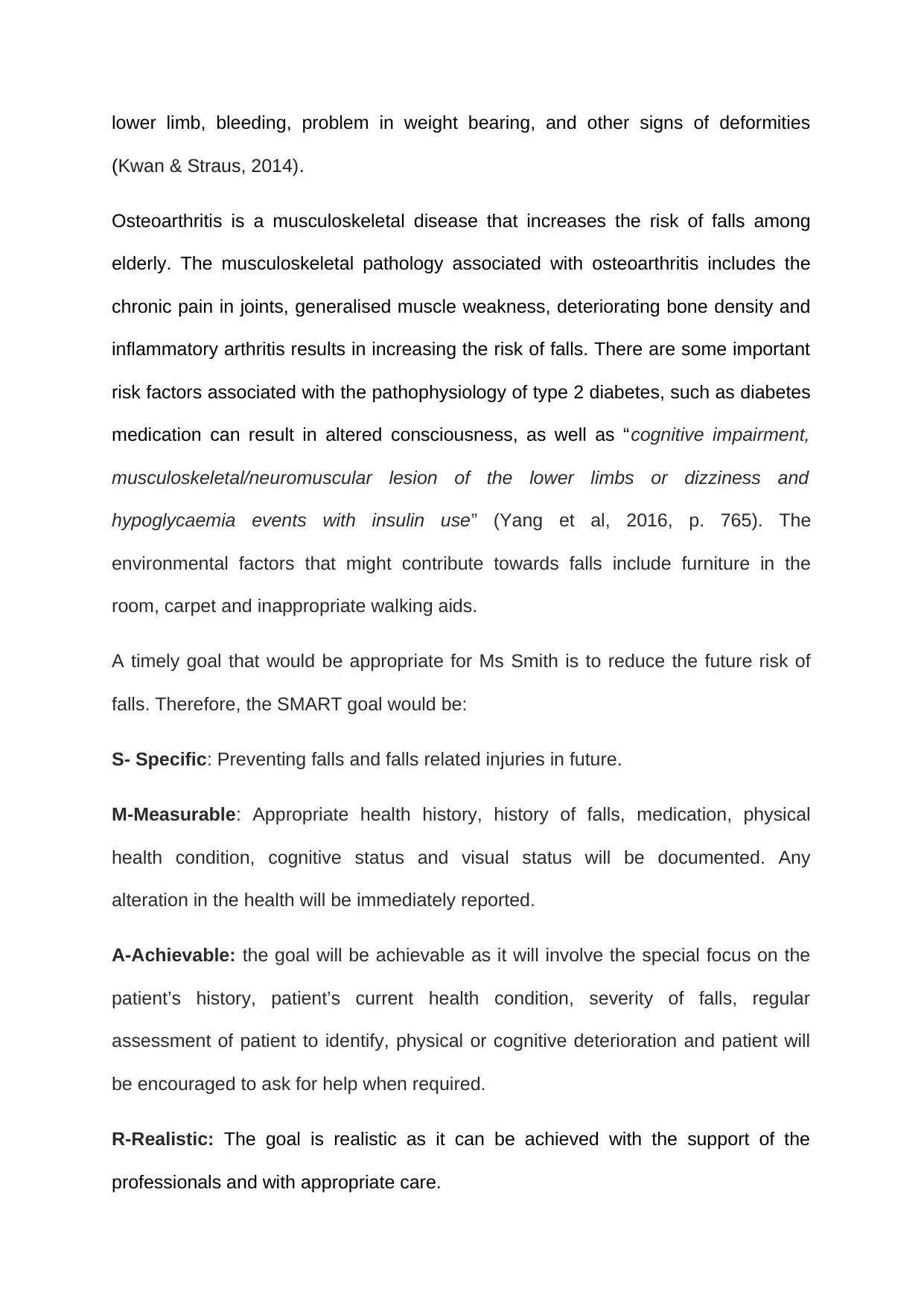
lower limb, bleeding, problem in weight bearing, and other signs of deformities
(Kwan & Straus, 2014).
Osteoarthritis is a musculoskeletal disease that increases the risk of falls among
elderly. The musculoskeletal pathology associated with osteoarthritis includes the
chronic pain in joints, generalised muscle weakness, deteriorating bone density and
inflammatory arthritis results in increasing the risk of falls. There are some important
risk factors associated with the pathophysiology of type 2 diabetes, such as diabetes
medication can result in altered consciousness, as well as “cognitive impairment,
musculoskeletal/neuromuscular lesion of the lower limbs or dizziness and
hypoglycaemia events with insulin use” (Yang et al, 2016, p. 765). The
environmental factors that might contribute towards falls include furniture in the
room, carpet and inappropriate walking aids.
A timely goal that would be appropriate for Ms Smith is to reduce the future risk of
falls. Therefore, the SMART goal would be:
S- Specific: Preventing falls and falls related injuries in future.
M-Measurable: Appropriate health history, history of falls, medication, physical
health condition, cognitive status and visual status will be documented. Any
alteration in the health will be immediately reported.
A-Achievable: the goal will be achievable as it will involve the special focus on the
patient’s history, patient’s current health condition, severity of falls, regular
assessment of patient to identify, physical or cognitive deterioration and patient will
be encouraged to ask for help when required.
R-Realistic: The goal is realistic as it can be achieved with the support of the
professionals and with appropriate care.
(Kwan & Straus, 2014).
Osteoarthritis is a musculoskeletal disease that increases the risk of falls among
elderly. The musculoskeletal pathology associated with osteoarthritis includes the
chronic pain in joints, generalised muscle weakness, deteriorating bone density and
inflammatory arthritis results in increasing the risk of falls. There are some important
risk factors associated with the pathophysiology of type 2 diabetes, such as diabetes
medication can result in altered consciousness, as well as “cognitive impairment,
musculoskeletal/neuromuscular lesion of the lower limbs or dizziness and
hypoglycaemia events with insulin use” (Yang et al, 2016, p. 765). The
environmental factors that might contribute towards falls include furniture in the
room, carpet and inappropriate walking aids.
A timely goal that would be appropriate for Ms Smith is to reduce the future risk of
falls. Therefore, the SMART goal would be:
S- Specific: Preventing falls and falls related injuries in future.
M-Measurable: Appropriate health history, history of falls, medication, physical
health condition, cognitive status and visual status will be documented. Any
alteration in the health will be immediately reported.
A-Achievable: the goal will be achievable as it will involve the special focus on the
patient’s history, patient’s current health condition, severity of falls, regular
assessment of patient to identify, physical or cognitive deterioration and patient will
be encouraged to ask for help when required.
R-Realistic: The goal is realistic as it can be achieved with the support of the
professionals and with appropriate care.

T-Timely: This goal is time bound therefore, the improvement in patient’s condition
will be achieved within a period of four weeks. Every change or deterioration as well
as improvement will be weekly documented.
The two evidence-based nursing interventions for falls risk assessment include:
1. Weekly falls risk assessment of the patient who are at higher risk of falls (such
as those suffering from chronic health condition, age, suffering from
musculoskeletal diseases etc.) (de Moura Sá et al, 2017).
2. Weekly exercise program conducted by the nurses and every session of two
hours combined with daily walking (de Moura Sá et al, 2017).
Question 2
SBAR Framework
S- Situation:
My name is ____ and I work _______
Risk of falls is the urgent safety issue for the patient.
Care is required according to the recent incident of fall
Ms Smith was found on the floor in the morning who had fallen. She was lying
on the floor with the walking stick.
May require change of medication.
Environmental risk factors are identified, according to which physical
environment of the patient’s room require alterations.
B-Background
Ms Smith is 84 years old woman living in Happy Valley Aged Care Facility.
will be achieved within a period of four weeks. Every change or deterioration as well
as improvement will be weekly documented.
The two evidence-based nursing interventions for falls risk assessment include:
1. Weekly falls risk assessment of the patient who are at higher risk of falls (such
as those suffering from chronic health condition, age, suffering from
musculoskeletal diseases etc.) (de Moura Sá et al, 2017).
2. Weekly exercise program conducted by the nurses and every session of two
hours combined with daily walking (de Moura Sá et al, 2017).
Question 2
SBAR Framework
S- Situation:
My name is ____ and I work _______
Risk of falls is the urgent safety issue for the patient.
Care is required according to the recent incident of fall
Ms Smith was found on the floor in the morning who had fallen. She was lying
on the floor with the walking stick.
May require change of medication.
Environmental risk factors are identified, according to which physical
environment of the patient’s room require alterations.
B-Background
Ms Smith is 84 years old woman living in Happy Valley Aged Care Facility.
Secure Best Marks with AI Grader
Need help grading? Try our AI Grader for instant feedback on your assignments.
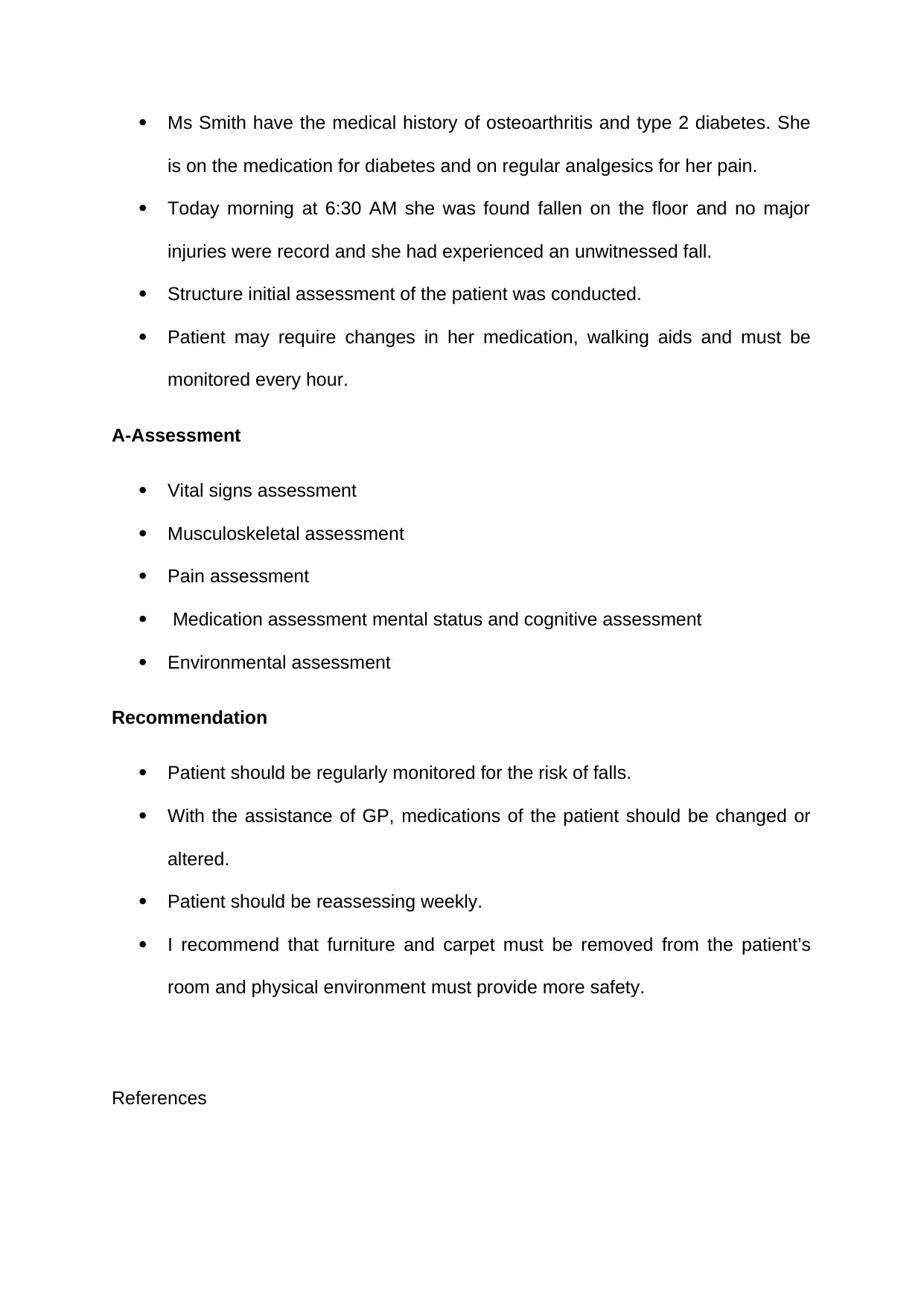
Ms Smith have the medical history of osteoarthritis and type 2 diabetes. She
is on the medication for diabetes and on regular analgesics for her pain.
Today morning at 6:30 AM she was found fallen on the floor and no major
injuries were record and she had experienced an unwitnessed fall.
Structure initial assessment of the patient was conducted.
Patient may require changes in her medication, walking aids and must be
monitored every hour.
A-Assessment
Vital signs assessment
Musculoskeletal assessment
Pain assessment
Medication assessment mental status and cognitive assessment
Environmental assessment
Recommendation
Patient should be regularly monitored for the risk of falls.
With the assistance of GP, medications of the patient should be changed or
altered.
Patient should be reassessing weekly.
I recommend that furniture and carpet must be removed from the patient’s
room and physical environment must provide more safety.
References
is on the medication for diabetes and on regular analgesics for her pain.
Today morning at 6:30 AM she was found fallen on the floor and no major
injuries were record and she had experienced an unwitnessed fall.
Structure initial assessment of the patient was conducted.
Patient may require changes in her medication, walking aids and must be
monitored every hour.
A-Assessment
Vital signs assessment
Musculoskeletal assessment
Pain assessment
Medication assessment mental status and cognitive assessment
Environmental assessment
Recommendation
Patient should be regularly monitored for the risk of falls.
With the assistance of GP, medications of the patient should be changed or
altered.
Patient should be reassessing weekly.
I recommend that furniture and carpet must be removed from the patient’s
room and physical environment must provide more safety.
References
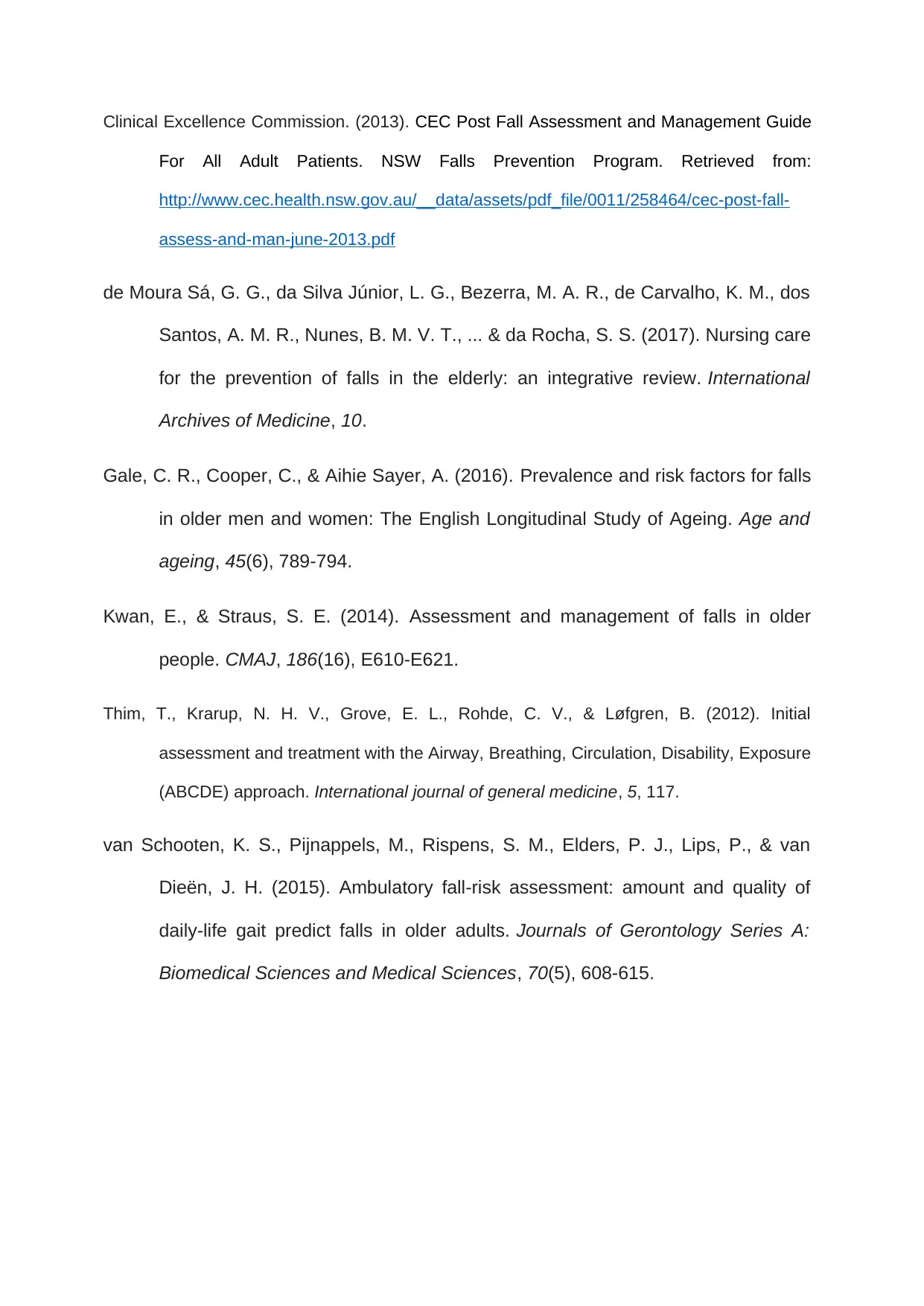
Clinical Excellence Commission. (2013). CEC Post Fall Assessment and Management Guide
For All Adult Patients. NSW Falls Prevention Program. Retrieved from:
http://www.cec.health.nsw.gov.au/__data/assets/pdf_file/0011/258464/cec-post-fall-
assess-and-man-june-2013.pdf
de Moura Sá, G. G., da Silva Júnior, L. G., Bezerra, M. A. R., de Carvalho, K. M., dos
Santos, A. M. R., Nunes, B. M. V. T., ... & da Rocha, S. S. (2017). Nursing care
for the prevention of falls in the elderly: an integrative review. International
Archives of Medicine, 10.
Gale, C. R., Cooper, C., & Aihie Sayer, A. (2016). Prevalence and risk factors for falls
in older men and women: The English Longitudinal Study of Ageing. Age and
ageing, 45(6), 789-794.
Kwan, E., & Straus, S. E. (2014). Assessment and management of falls in older
people. CMAJ, 186(16), E610-E621.
Thim, T., Krarup, N. H. V., Grove, E. L., Rohde, C. V., & Løfgren, B. (2012). Initial
assessment and treatment with the Airway, Breathing, Circulation, Disability, Exposure
(ABCDE) approach. International journal of general medicine, 5, 117.
van Schooten, K. S., Pijnappels, M., Rispens, S. M., Elders, P. J., Lips, P., & van
Dieën, J. H. (2015). Ambulatory fall-risk assessment: amount and quality of
daily-life gait predict falls in older adults. Journals of Gerontology Series A:
Biomedical Sciences and Medical Sciences, 70(5), 608-615.
For All Adult Patients. NSW Falls Prevention Program. Retrieved from:
http://www.cec.health.nsw.gov.au/__data/assets/pdf_file/0011/258464/cec-post-fall-
assess-and-man-june-2013.pdf
de Moura Sá, G. G., da Silva Júnior, L. G., Bezerra, M. A. R., de Carvalho, K. M., dos
Santos, A. M. R., Nunes, B. M. V. T., ... & da Rocha, S. S. (2017). Nursing care
for the prevention of falls in the elderly: an integrative review. International
Archives of Medicine, 10.
Gale, C. R., Cooper, C., & Aihie Sayer, A. (2016). Prevalence and risk factors for falls
in older men and women: The English Longitudinal Study of Ageing. Age and
ageing, 45(6), 789-794.
Kwan, E., & Straus, S. E. (2014). Assessment and management of falls in older
people. CMAJ, 186(16), E610-E621.
Thim, T., Krarup, N. H. V., Grove, E. L., Rohde, C. V., & Løfgren, B. (2012). Initial
assessment and treatment with the Airway, Breathing, Circulation, Disability, Exposure
(ABCDE) approach. International journal of general medicine, 5, 117.
van Schooten, K. S., Pijnappels, M., Rispens, S. M., Elders, P. J., Lips, P., & van
Dieën, J. H. (2015). Ambulatory fall-risk assessment: amount and quality of
daily-life gait predict falls in older adults. Journals of Gerontology Series A:
Biomedical Sciences and Medical Sciences, 70(5), 608-615.
1 out of 6
Related Documents
Your All-in-One AI-Powered Toolkit for Academic Success.
+13062052269
info@desklib.com
Available 24*7 on WhatsApp / Email
![[object Object]](/_next/static/media/star-bottom.7253800d.svg)
Unlock your academic potential
© 2024 | Zucol Services PVT LTD | All rights reserved.





